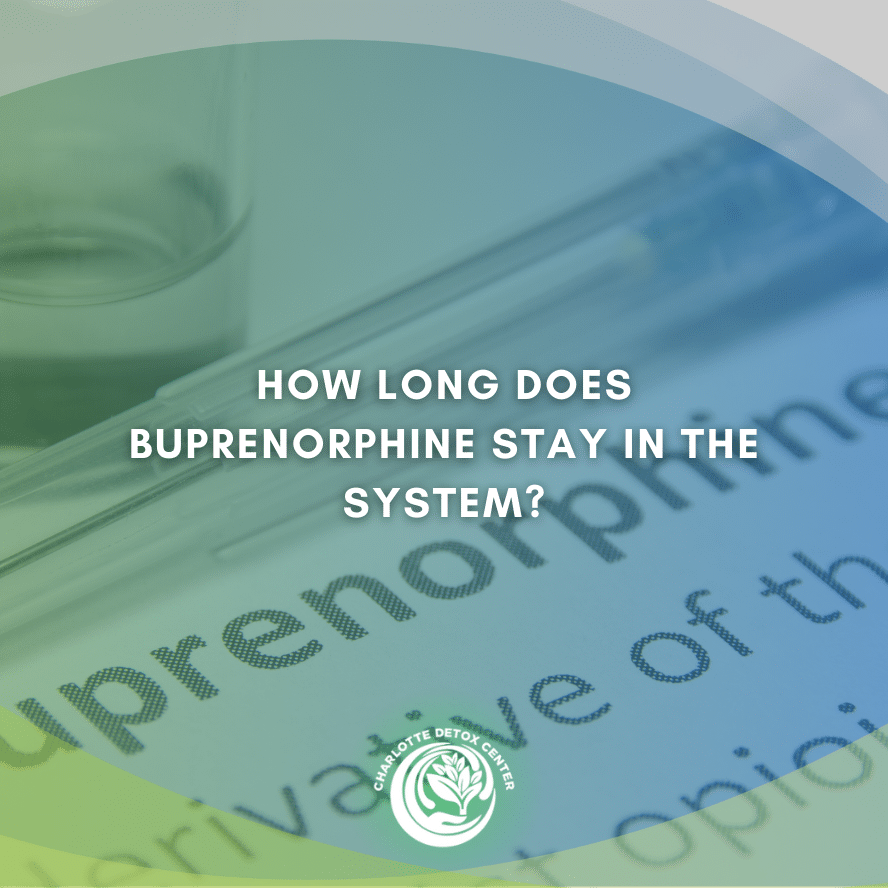How Long Does Buprenorphine Stay in The System?

Medically Verified: 2/1/24
Medical Reviewer
Chief Editor

All of the information on this page has been reviewed and verified by a certified addiction professional.
Buprenorphine is a medication used to prevent opioid withdrawal symptoms for individuals who are recovering from opioid addiction.[1] Additionally, some individuals may be prescribed buprenorphine for pain relief if they cannot use other forms of pain-relieving medications. This medication is a mixed opioid partial agonist-antagonist.
Buprenorphine is sold under the brand names Suboxone (buprenorphine and naloxone), Subutex, Belbuca, Butrans, and Bupe. It is also available in a monthly injection known as Sublocade. Any product that contains buprenorphine is classified as a Schedule III drug, meaning it has a moderate to low potential for abuse.
While buprenorphine has a low potential for abuse, individuals who have never abused opioids in the past may feel an effect from the medication. This leaves those individuals vulnerable to abusing buprenorphine. With that being said, let’s take a look at how long buprenorphine stays in a person’s system.



How Long Does Buprenorphine Last?
The half-life of buprenorphine is 24-48 hours. The substance is broken down by the liver, moves into the kidneys, and is excreted through urine. Suboxone, on the other hand, has a shorter half-life of only 2-12 hours. This is because naloxone shortens the elimination period of the drug. Buprenorphine is a long-lasting and powerful medication, so individuals must be monitored for possible severe reactions, especially if they have never taken buprenorphine before.
How Long Can Buprenorphine Be Detected in The System?

While buprenorphine is an opioid, it may not be tested for on urine or saliva drug screening tests that are given by employers. This is because buprenorphine has a different metabolite (norbuprenorphine) than commonly abused opioids. However, testing for buprenorphine is becoming more common.
Each method of testing can detect buprenorphine in an individual’s system for varying lengths of time.
Blood
Blood tests tend to be less common because they are invasive and typically cost more than other methods of drug screening. However, buprenorphine can be detected in a blood test for 2 days after an individual’s last dose. It is important to note that blood tests have a shorter window of detection time than urine tests.
Urine
Buprenorphine is detected in urine tests for up to 6 days after the individual’s last dose. If a patient is taking buprenorphine as prescribed by a doctor, it is important they notify labs so they can distinguish between buprenorphine abuse and proper use of the drug.
Hair
Research has found that buprenorphine is detectable through a hair sample.[2] As with any substance, the detection window for buprenorphine through hair samples is much longer than any other method of drug testing. Buprenorphine can be detected in head hair follicle samples for up to three months after an individual’s last dose.[3]
Saliva
Saliva tests are a fast and accurate tool for detecting the presence of buprenorphine in an individual’s system.[4] These tests may be used more frequently than others as they are easy to administer and have a slightly longer window of detection than blood tests. Buprenorphine can be detected in the saliva for 3 days after the last dose was administered.
Factors That Affect Buprenorphine Detection Time
There is no one answer for the detection time of buprenorphine in the system due to several factors that influence how long it takes an individual’s body to metabolize and eliminate the drug. The most notable factors in how long buprenorphine stays in the system include age, liver function, and overall health.
Age
Prescribing buprenorphine to older adults should always be done with extreme caution. This is because older adults experience a decrease in heart, liver, and kidney functioning. In addition, the presence of other diseases and additional medications may impact how long it takes for buprenorphine to leave the body. Additionally, older adults usually need to take smaller doses of buprenorphine.
Liver Function
Buprenorphine is metabolized and eliminated by the liver. Because of this, hepatic impairment is known to influence how long it takes buprenorphine to be excreted from one’s system. The half-life of buprenorphine is longer for individuals with moderate to severe liver impairment.
Overall Health
An individual’s overall health has a significant impact on how long it takes their body to process and excrete different substances. The same is true for buprenorphine. If someone’s health is in good condition and they have a fast metabolism, they will clear the drug at a faster rate. On the other hand, individuals with slower metabolisms will take longer to eliminate buprenorphine from their bodies.
How Long Does Sublocade (Buprenorphine Injection) Stay in The System?
Sublocade is an extended-release injectable form of buprenorphine. After the initial injection, the medication remains available in the body at a steady level for up to 30 days. Depending on the previously mentioned individual factors, the drug can stay in a person’s system for varying amounts of time. However, most drug tests will detect Sublocade for the same amount of time after the effects of the substance wear off as they would other forms of buprenorphine.
When trying to estimate how long buprenorphine will stay in an individual’s system, an array of variables must be considered. This includes which type of formulation of the drug is used, whether the individual is using other substances, and the person’s metabolism.
If you or a loved one suffer from substance abuse, contact Charlotte Detox Center today. We can help you recover from addiction in a safe and inclusive environment.
References:
- https://www.futuremedicine.com/doi/10.2217/pmt.12.26
- https://analyticalsciencejournals.onlinelibrary.wiley.com/doi/10.1002/dta.1611
- https://pubmed.ncbi.nlm.nih.gov/24713865/
- https://www.omicsonline.org/open-access/rapid-identification-of-buprenorphine-in-patient-saliva-2155-9872-1000368.php?aid=90955
